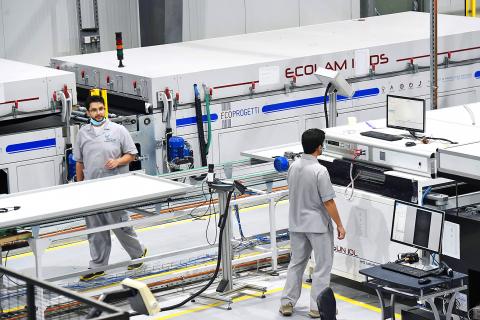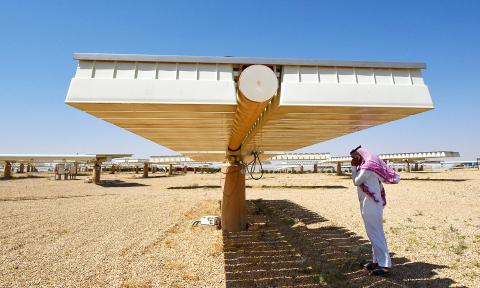Saudi engineers whip up a simulated sandstorm to test a solar panel’s durability at a research lab, the heart of the oil-rich kingdom’s multibillion dollar quest to be a renewable energy powerhouse.
The world’s top exporter of crude seems an unlikely champion of clean energy, but the government lab in Al Uyayna, a sun-drenched village near Riyadh, is leading the country’s efforts for solar power as it seeks to diversify.
A dazzling spotlight was shone on those ambitions last week when Crown Prince Mohammed bin Salman unveiled plans to develop the globe’s biggest solar power project for US$200 billion in partnership with Japan’s SoftBank group.

Photo: AFP
The memorandum of understanding to produce up to 200 gigawatts of power by 2030 — about 100 times the capacity of the current biggest projects — was the latest jaw-dropping statement as the Saudis look to wean themselves off oil.
If built on one site, the solar farm would cover an area twice the size of Hong Kong, according to a Bloomberg News calculation.
While the scale of the plan has stirred some disbelief — the agreement announced in the US was greeted with determination at the laboratory.

Photo: AFP
“We can do it,” said Adel al-Sheheween, director of the solar laboratory under the King Abdulaziz City for Science and Technology.
“This may take time, but we have all the raw materials — sunshine, land and most importantly, the will,” he added, giving AFP a tour of the facility widely known as Solar Village.
Engineers were working away testing solar panels under harsh conditions.
A miniature sandstorm inside a cylindrical chamber battered one panel. A machine with what appeared to be a large boxing glove punched another.
‘EXPORTER OF GIGAWATTS’
The site, which also includes a solar field that supplies electricity to neighboring villages, was established some three decades ago.
But the push for renewables only now appears to be gaining momentum.
It is driven by a key incentive — to free up more oil reserves for export, the kingdom’s chief revenue earner.
Saudi Arabia currently draws on oil and natural gas to both meet its own fast-growing power demand and desalinate its water, consuming an estimated 3.4 million barrels of oil daily.
That number is expected to rise to 8.3 million barrels in 10 years, according to the King Abdullah City for Atomic and Renewable Energy, eating up the bulk of Saudi Arabia’s crude production.
“Saudi Arabia has long had a vision for becoming... an exporter of oil and of gigawatts of power,” said Ellen Wald, a scholar at pro-Saudi think tank Arabia Foundation and author of the book Saudi Inc.
“That vision requires solar power installations of a massive scale. My understanding is the project will be rolled out in pieces and not as one giant plant.”
But the sheer scope of the project, which aims to produce well above the kingdom’s own projected requirement of 120 gigawatts by 2032, has prompted skepticism.
“Although Saudi Arabia has more than enough vacant, non-arable desert land... (it) really does not need so much solar power,” said Bart Lucarelli, a managing director for power and utilities at advisory firm AWR Lloyd.
“There has been speculation about whether this amount of new solar capacity can even be built in that time frame within a single country. The consensus view is that the 200 gigawatt figure is excessive.”
Lucarelli said Saudi Arabia instead “needs a balance” between renewables and fossil fuels — and pointed out that the solar memorandum is non-binding for now. To handle the amount of power the project envisions, experts say the kingdom would require huge investments to upgrade its grid and set up large-scale battery storage facilities.
‘GIGA PROJECTS’
The solar push appears to be driven by geopolitics as much as economics.
“Saudia Arabia’s problem is that (rivals) Iran and Qatar have the gas reserves it does not,” said James Dorsey, a Middle East expert at the S. Rajaratnam School of International Studies in Singapore.
“That is one reason why renewables figure prominently in Prince Mohammed’s reform program, not only to prepare Saudi Arabia economically for a post-oil future but also to secure its continued geopolitical significance.”
Saudi Arabia also harbors atomic ambitions, with plans to build 16 reactors over the next two decades for US$80 billion, despite concerns over nuclear proliferation in the Middle East.
But the economics favor solar power. Electricity from solar sources costs less than half that of nuclear power.
SoftBank’s Vision Fund would invest US$1 billion for the first phase of the deal, but it is unclear where the rest of the investment will come from. Saudi Arabia has dazzled investors with several plans for hi-tech “giga projects,” funded in part by its sovereign wealth fund, but skeptics question their viability in an era of cheap oil. The kingdom has unveiled blueprints to build NEOM, a mega project billed as a regional Silicon Valley, in addition to the Red Sea project, a reef-fringed resort destination — both worth hundreds of billions of dollars.
“Throwing money at a project, be it a solar project or a tech city, won’t make it work unless it’s accompanied by technology that works and effective project management,” said Wald.
“Most likely, the end result of mega projects will be markedly different than the vision expressed today. That is not to say worse, but different,” she said.

The Taipei Times last week reported that the rising share of seniors in the population is reshaping the nation’s housing markets. According to data from the Ministry of the Interior, about 850,000 residences were occupied by elderly people in the first quarter, including 655,000 that housed only one resident. H&B Realty chief researcher Jessica Hsu (徐佳馨), quoted in the article, said that there is rising demand for elderly-friendly housing, including units with elevators, barrier-free layouts and proximity to healthcare services. Hsu and others cited in the article highlighted the changing family residential dynamics, as children no longer live with parents,

Oct 20 to Oct 26 After a day of fighting, the Japanese Army’s Second Division was resting when a curious delegation of two Scotsmen and 19 Taiwanese approached their camp. It was Oct. 20, 1895, and the troops had reached Taiye Village (太爺庄) in today’s Hunei District (湖內), Kaohsiung, just 10km away from their final target of Tainan. Led by Presbyterian missionaries Thomas Barclay and Duncan Ferguson, the group informed the Japanese that resistance leader Liu Yung-fu (劉永福) had fled to China the previous night, leaving his Black Flag Army fighters behind and the city in chaos. On behalf of the

I was 10 when I read an article in the local paper about the Air Guitar World Championships, which take place every year in my home town of Oulu, Finland. My parents had helped out at the very first contest back in 1996 — my mum gave out fliers, my dad sorted the music. Since then, national championships have been held all across the world, with the winners assembling in Oulu every summer. At the time, I asked my parents if I could compete. At first they were hesitant; the event was in a bar, and there would be a lot

The election of Cheng Li-wun (鄭麗文) as chair of the Chinese Nationalist Party (KMT) marked a triumphant return of pride in the “Chinese” in the party name. Cheng wants Taiwanese to be proud to call themselves Chinese again. The unambiguous winner was a return to the KMT ideology that formed in the early 2000s under then chairman Lien Chan (連戰) and president Ma Ying-jeou (馬英九) put into practice as far as he could, until ultimately thwarted by hundreds of thousands of protestors thronging the streets in what became known as the Sunflower movement in 2014. Cheng is an unambiguous Chinese ethnonationalist,